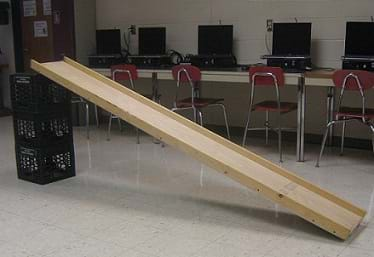Materials List:
E.G. Benedict's Ambulance Patient Safety Challenge
 https://www.teachengineering.org/activities/view/wpi_ambulance_activity1
https://www.teachengineering.org/activities/view/wpi_ambulance_activity1

Each group needs:
- 1 wooden small-scale prototype ambulance frame made from ¼-in x 1½-in x 6-in (.64-cm x 3.2-cm x 15.3-cm) wood plank with wheels attached using hot glue, as shown in Figure 2; pine recommended; see details in Procedures section
- 2 metal axles, such as stock #390361 at http://www.kelvin.com, 1/8-in diameter x 2½-in long steel rods (.32-cm x 6.4-cm)
- 2 plastic straw axle holders, such as stock #330327 at http://www.kelvin.com, ¼-in diameter x 7¾-in long (.64-cm x 19.69-cm)
- 4 plastic wheels, such as stock #990168 at http://www.kelvin.com, 1 3/8-in (3.5-cm) diameter, 3/32-in (.29-cm) tread width, center hole fits 1/8-in axle
- 1 raw egg in its shell
- hot glue gun
- tin snips, for cutting cardboard
- scissors
- computers with internet access, for conducting background research
- graph paper, ruler and pencil, one each per student
- Engineering Design Process Graphic Organizer, one per student
- Guided Background Research Worksheet, one per student
- Ambulance Engineering Design Project Packet, one per student
To share with the entire class:
- computer with internet access and projector to show students a short YouTube video
- E.G. Benedict's Ambulance Project Poster, a visual aid to either show the class via computer or overhead projector, post in classroom, or make handouts
- 1 adjustable "roadway" ramp, made from plywood, 8-ft long x 1.5-ft wide x 1/2-in thick (2.4-m x 45.7-cm x 1.27-cm), as shown in Figure 1)
- 5 milk crates, used to prop-up ramp at different levels, as shown in Figure 1
- a variety of recycled "building" materials, such as assorted types of cardboard (corrugated, cereal boxes, etc.), rubber bands, cotton balls, paperclips, string, plastic wrap, packing peanuts, bubble wrap; ask students to bring these types of found materials from home
- hot glue sticks
- masking tape
- wood saw, to cut wheel notches for ambulance frame (if necessary)
- (optional) drill and bits, to place small holes around ambulance frame as attachment points
- scale or triple-beam-balance, to weigh prototype ambulances
 https://www.teachengineering.org/activities/view/wpi_ambulance_activity1
https://www.teachengineering.org/activities/view/wpi_ambulance_activity1